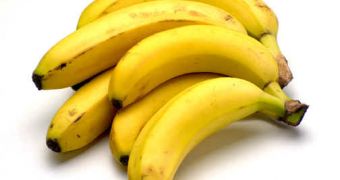1. Despite the name of banana tree, Musa paradisiaca is a 7-8 m (23-27 ft) tall and robust grass, with a tree-like aspect. It has a false trunk made of the well developed sheaths of the leaves wrapping each other (the proper stem is very short). Upper leaves are very large, over 2 m (6.6 ft) in length and 40 cm (1.3 ft) wide. The plant originated in tropical Asia.
2. Flowers are hermaphrodite or unisex. At the end of the false trunk grows a large inflorescence, tilted sideways. The red large male flowers are located on the tip of the inflorescence, while at the base of the inflorescence the female flowers that will form the bananas are located, forming rich clusters of up to 50 kg (110 pounds). A plantation gives about 30 tonnes of bananas per hectare. After fructifying, the plant dies leaving behind numerous shoots that will form other banana trees next year.
3. Because the leaves have antiseptic properties, they are used as "dishes" by many tropical populations.
4. During the marriage ceremony of Rais and Limbu in Nepal, a sacrificed chicken is made pour blood over a banana leaf placed close to the threshold of the house. The bride must stay for a moment over the blood soaked leaf before entering her future home. Bananas are considered a symbol of fecundity in many cultures.
5. The ash resulted from the burning of dry leaves and stems is rich in potassium and used as a remedy for stomach acidity, intestinal colics and skin ulcerations. The fresh juice of the plant has constrictive properties in external and internal hemorrhages, being used also in case of nervous affections, like hysteria and epilepsy, against dysentery or intoxications with opium.
6. Raw fruits reduce the sugar amount in the blood while mature fruits are contraindicated in case of diabetes (they contain 18 % sugar).
7. Banana roots have tonic properties, being indicated in affections of gall bladder. the 8. Infusions made of banana flowers are indicated in case of diabetes.

 14 DAY TRIAL //
14 DAY TRIAL //